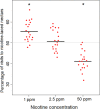Nicotine in floral nectar pharmacologically influences bumblebee learning of floral features
- PMID: 28512323
- PMCID: PMC5434031
- DOI: 10.1038/s41598-017-01980-1
Nicotine in floral nectar pharmacologically influences bumblebee learning of floral features
Abstract
Many plants defend themselves against herbivores by chemical deterrents in their tissues and the presence of such substances in floral nectar means that pollinators often encounter them when foraging. The effect of such substances on the foraging behaviour of pollinators is poorly understood. Using artificial flowers in tightly-controlled laboratory settings, we examined the effects of the alkaloid nicotine on bumblebee foraging performance. We found that bumblebees confronted simultaneously with two equally rewarded nicotine-containing and nicotine-free flower types are deterred only by unnaturally high nicotine concentrations. This deterrence disappears or even turns into attraction at lower nectar-relevant concentrations. The alkaloid has profound effects on learning in a dose-dependent manner. At a high natural dose, bees learn the colour of a nicotine-containing flower type more swiftly than a flower type with the same caloric value but without nicotine. Furthermore, after experiencing flowers containing nicotine in any tested concentration, increasing numbers of bumblebees stay more faithful to these flowers, even if they become a suboptimal choice in terms of reward. These results demonstrate that alkaloids enhance pollinator flower constancy, opening new perspectives in co-evolutionary process between plants and pollinators.
Conflict of interest statement
The authors declare that they have no competing interests.
Figures




Similar articles
-
Bumblebees are not deterred by ecologically relevant concentrations of nectar toxins.J Exp Biol. 2014 May 1;217(Pt 9):1620-5. doi: 10.1242/jeb.097543. Epub 2014 Feb 13. J Exp Biol. 2014. PMID: 24526720 Free PMC article.
-
Distasteful Nectar Deters Floral Robbery.Curr Biol. 2017 Aug 21;27(16):2552-2558.e3. doi: 10.1016/j.cub.2017.07.012. Epub 2017 Aug 10. Curr Biol. 2017. PMID: 28803876
-
Nectar quality changes the ecological costs of chemically defended pollen.Curr Biol. 2019 Jul 22;29(14):R679-R680. doi: 10.1016/j.cub.2019.05.046. Curr Biol. 2019. PMID: 31336081
-
Secondary compounds in floral rewards of toxic rangeland plants: impacts on pollinators.J Agric Food Chem. 2014 Jul 30;62(30):7335-44. doi: 10.1021/jf500521w. Epub 2014 May 15. J Agric Food Chem. 2014. PMID: 24766254 Review.
-
Lingering Effects of Herbivory and Plant Defenses on Pollinators.Curr Biol. 2018 Oct 8;28(19):R1164-R1169. doi: 10.1016/j.cub.2018.08.010. Curr Biol. 2018. PMID: 30300606 Review.
Cited by
-
Learning modifies attention during bumblebee visual search.Behav Ecol Sociobiol. 2024;78(2):22. doi: 10.1007/s00265-024-03432-z. Epub 2024 Feb 6. Behav Ecol Sociobiol. 2024. PMID: 38333735 Free PMC article.
-
A guide to sunflowers: floral resource nutrition for bee health and key pollination syndromes.Front Plant Sci. 2025 May 1;16:1552335. doi: 10.3389/fpls.2025.1552335. eCollection 2025. Front Plant Sci. 2025. PMID: 40376158 Free PMC article. Review.
-
Male flowers of Aconitum compensate for toxic pollen with increased floral signals and rewards for pollinators.Sci Rep. 2019 Nov 11;9(1):16498. doi: 10.1038/s41598-019-53355-3. Sci Rep. 2019. PMID: 31712605 Free PMC article.
-
Secondary Metabolites in Nectar-Mediated Plant-Pollinator Relationships.Plants (Basel). 2023 Jan 25;12(3):550. doi: 10.3390/plants12030550. Plants (Basel). 2023. PMID: 36771634 Free PMC article. Review.
-
Invasive ant learning is not affected by seven potential neuroactive chemicals.Curr Zool. 2023 Feb 7;70(1):87-97. doi: 10.1093/cz/zoad001. eCollection 2024 Feb. Curr Zool. 2023. PMID: 38476136 Free PMC article.
References
-
- Adler LS. The ecological significance of toxic nectar. Oikos. 2000;91:409–420. doi: 10.1034/j.1600-0706.2000.910301.x. - DOI
-
- Baker HG. Non-sugar chemical constituents of nectar. Apidologie. 1977;8:349–356. doi: 10.1051/apido:19770405. - DOI
-
- Vanbergen AJ. Threats to an ecosystem service: pressures on pollinators. Front. Ecol. Environ. 2013;11:251–259. doi: 10.1890/120126. - DOI
-
- Nicolson, S. W. & Thornburg, R. W. In Nectaries and nectar 215–264 (Springer, 2007).
Publication types
MeSH terms
Substances
LinkOut - more resources
Full Text Sources
Other Literature Sources

